Steinberg Media Technologies GmbH
Dorico is the highly successful music notation software from Steinberg, a wholly owned subsidiary of Yamaha, one of the world’s leading producers of audio and music hard- and software.
Even a quick glance at MyMac’s reviews of Dorico – versions 1 and 2 – will provide some insight into why and how Dorico excels as a spectacularly rich environment in which compose, edit, arrange and engrave music for performance and publication to the highest (professional) standards.
In a surprisingly short period of time Dorico was designed and written from scratch. Its development team was able to avoid some of the legacy constraints with which Dorico’s two competitor packages understandably have to work. Sibelius and Finale were first conceived and built several decades ago. The world has moved on; many new ways have emerged of putting your creativity first, not your knowledge of computing. Musicians are more grateful than ever for being able to work like this – but with keyboard and mouse. They have Dorico to thank for being at the forefront of successfully re-aligning emphasis and focus.
Dorico 3 was released at the beginning of September. It’s packed with major new features, and improvements across the board. Existing users should not hesitate to upgrade to version 3. New users can also be assured that Dorico represents the future of computer-based music notation, and that Dorico 3 is the best version yet. As with versions 1 and 2, Dorico 3 is priced competitively when compared with the other two major products in the field of serious, advanced music notation. There is a full pricing table at the end of this review.
From its first appearance Dorico actively encouraged you to design and execute almost any musical workflow in the same way as serious musicians (would) do with traditional methods… manuscript paper and pencil etc. Not as computers force them to… the order in which Dorico expects many parameters to be set, for instance, is the order in which a composer handles them.
Much of Dorico’s success – and indeed its claim now to be the leading system of its kind – can be attributed to the huge array of skills and energy of the teams in London and Hamburg which work on Dorico, and support it.
Take a look, for example, at the extremely lively forum: Steinberg (support) staff seem to be participating helpfully in the discussions day and night and all through the weekends. Puzzles and problems which users come across with Dorico are usually dealt with on its forum extremely quickly – either by other knowledgeable users, or by Daniel Spreadbury (Dorico’s Product Manager) and his team.
Indeed, it’s a real incentive to use Dorico rather than its competitor products when there is such a high probability that even the most complex of questions posed by (new) users will be resolved within a matter of hours. Unusually complex? Yes: after all the notation of serious music adheres to standards which originated many centuries ago and are still evolving.
Dorico 3
To do Dorico 3 justice three main areas of this new version need to be examined here:
- completely new features and functionality – such as “Condensing†and full support for guitar notation with fingering, string indicators, tablature, chord diagrams etc
- functionality, workflows which were already present in Dorico 2 (and in many cases Dorico 1) which have been significantly changed for the better – such as the Edit Lyrics dialog
- many smaller fixes and touches which don’t represent rethinks on Steinberg’s part, but will improve the user’s experience – sometimes substantially; these include better fingering, chord symbols’ “regionsâ€, multi-rests, staff labeling, dynamics, arpeggios, ossias and so on.
Dorico 3 – like version 2 – comes in “Pro†and “Elements†versions. Consult this page for differences.
Dorico 3 combines the advantages of a major upgrade having a host of new features – many unavailable in its competitor products – with the introduction of other improvements, and some fixes. These have been engineered in Dorico 3 in such a way that the familiarity which a user has already gained with Doricos 1 and 2 is neither challenged nor wasted: everything will just fit into place. No jars or jolts. Few surprises, all good. No regrets!
It’s tempting to think that Spreadbury and his team have looked across the board at everything that was either lacking/missing from earlier versions on the one hand; and at everything which could be improved in the software on the other. Then that they have deftly swept them all into this major update adding just the right amount and kind of actual interface/usability refinements amply to justify Dorico 3’s strap, “More Beauty More Brainsâ€. And this on top of the smaller, incremental, releases of each existing version of Dorico throughout the rest of the year.
But there’s more to it than that: Dorico 3 retains an unmistakable sense that you are working with a piece of software which has been planned holistically. It’s not a collection of tools. It’s an all-in world in which composers, arrangers and performers come almost to “liveâ€.
Condensing
Notation software which is merely adequate will record the notes as input so that they can be performed, player by player. Notation software which is outstanding will add features that appear to anticipate the ways in which musical performance actually happens. Then it will implement them so as to save musicians significant time and effort, without surrendering control.
A good example of one of the many ways in which Dorico 3 now leads the pack in this way is the new feature that Steinberg calls “Condensingâ€.
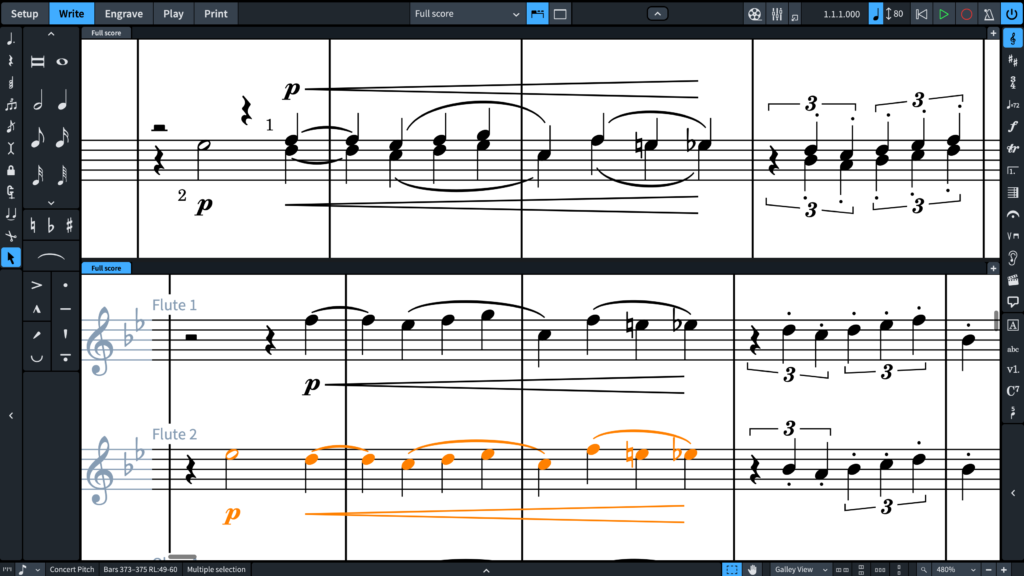
The score from which a conductor works in performance for a (chamber) orchestral, opera or (large) choral piece is often “reduced†so that all the pertinent information (entries, tacets, changes in dynamics and tempi etc) is available to the conductor with nothing necessary to the performance omitted.
Yet at the same time a score must be produced which is readable, physically manageable and where no information has been lost as copyists edit, combine, amalgamate, and excise the material on sometimes up to two (at times more) dozen parts/staves.
They generally condense what has been written for individual players on individual staves into one workable score with larger and fewer staves. As you can imagine, there is often an element of compromise here. Physical size is important. Comprehensiveness of movement through the score is also vital.
The process of aggregating everything, losing nothing essential and ending up with such a score is – understandably – immensely complex and laborious when done by hand.
Dorico 3 has automated the process.
And it has done so remarkably successfully. And with a single click. And, of course, while retaining all the individual parts in the project. This compromise reflects the best of both worlds.
The intelligence which has gone into this new feature is impressive. Dorico 3’s condensing algorithms are relatively sophisticated. They truly do respect the principles of notation and performance. They take account of which instruments and instrument families are candidates for condensing; which usually can and/or should not be condensed; and/or which may actually work only in certain circumstances.
Dorico 3’s new condensing feature also allows for the opposite eventuality – when expected groups need to be excluded. Indeed, custom condensing groups can be built, maintained and applied. Users have the power to override and fine-tune (the annotation which adorns) such condensing procedures.
It may help to conceptualize how condensing fits into the bigger picture. Condensed music can’t be edited in Dorico 3’s Write mode. It’s an end product. But – typical of the flexibility of Dorico – fine graphical and positional adjustments can still be made in Engraving mode. The relevant clip for “Condensing†on this page (courtesy and © 2019 Steinberg Media Technologies GmbH) will also explain why and how this dynamic new feature works.
As said, Dorico 3 is the only notation software to have this functionality. For orchestral composers, arrangers and performers you could argue that condensing is worth the price of the upgrade alone.
But of course it’s only one of many such new features…
Guitar and harp (smart pedaling)
… another new feature in Dorico 3 is the introduction of significantly enhanced support for the ways in which music for the guitar and other fretted instruments is now handled: tablature notation.
You can now choose whether to display such scores/parts as staves like most other instruments; as guitar tabs; or both. In the latter case, changes to one are instantly and automatically reflected in the other. Left- and right-handed fingering are both supported. The different ways of dealing with rhythmic information are also supported.
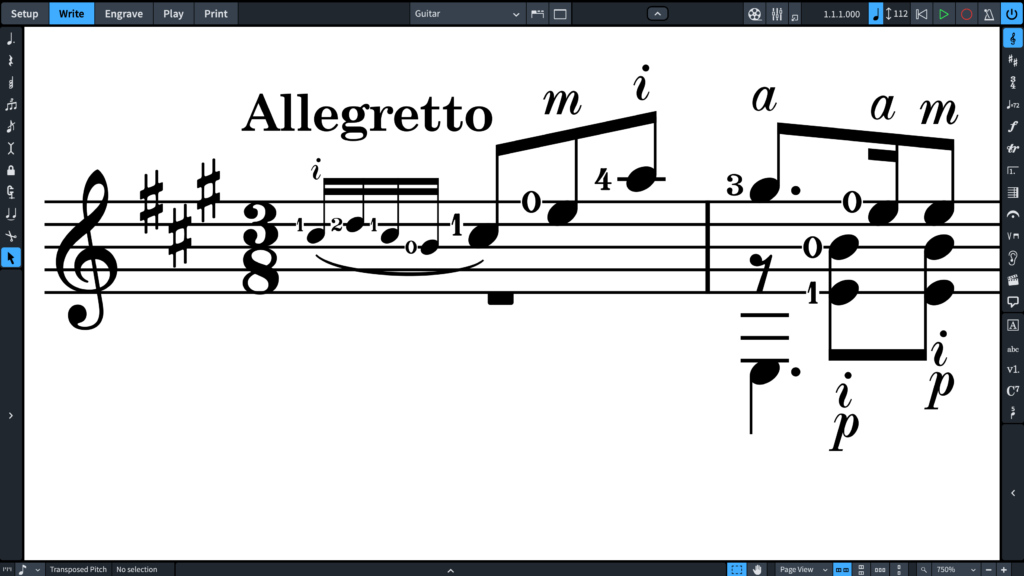
Fretboards with irregular spacing like the dulcimer are accommodated too; as are those instruments with different length strings, like the banjo. What’s more, the many ways to show chord diagrams are all catered for. But again typical of Dorico’s musician-centered approach, these are based on the actual shapes which players’ hands take, rather than an attempt to mirror fret positions. And – equally characteristic of Dorico’s strengths – you can also design your own. Dorico 3 now also supports guitar bends and pre-bends, full control of which is in Write mode’s Ornaments > Glissandi menu.
Notation for the harp sometimes seems to be in a world of its own. Dorico 3’s approach is to “smarten†the entry and editing of such notation. But that’s not the whole story: the harp in Dorico 3 now has its own tool to create pedal diagrams. This is no small achievement. You can choose graphical diagrams, note names and partial pedal names under their own menu item in Write mode.
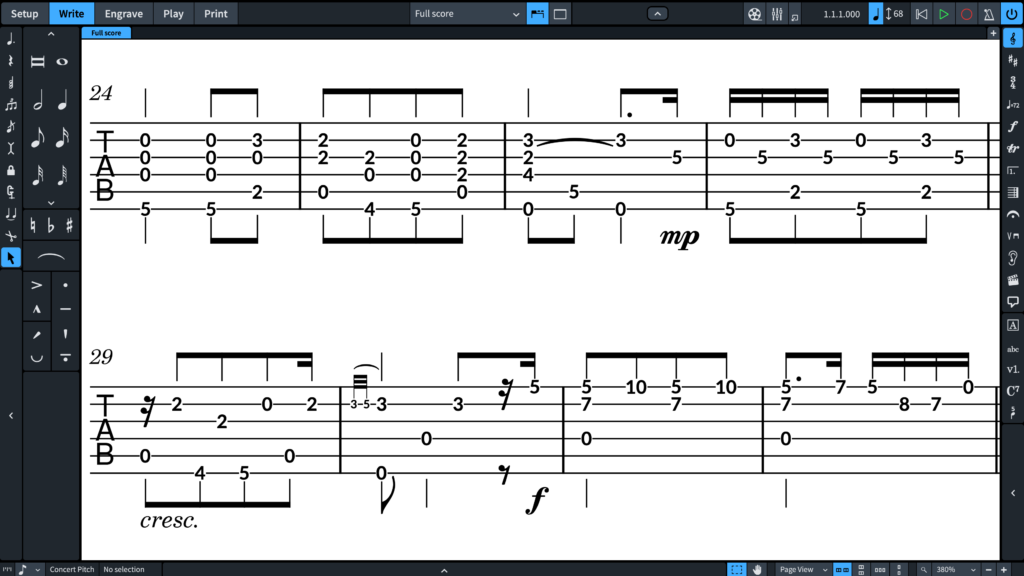
Once again, Dorico uses obviously intelligent algorithms to arrive at notational accuracy based on context. This goes a long way towards indicating unplayable pitches (when the View > Notes And Rest Colors > Notes Out Of Range option is checked). As is the case with Condensing, Dorico 3’s Engrave mode supports final fine-tuning of such notational subtleties before printing. In this area too, Dorico 3 is ahead of competitor products.
Playback
Earlier versions of Dorico attracted some criticism from users who wanted to concentrate on “local†reproduction of their music (playing it back on their own computer and audio system) as much as, perhaps even more than, producing scores for engraving and (live) performance. But over time (and it’s still almost impossible to believe that a product as mature as this one is the result of as little as three years’ work after initial release) that situation has steadily improved.
Dorico 3, however, brings yet more major developments in playback. In the first place it’s now significantly easier to work with the many third-party collections of Virtual Instruments (VIs) – like EastWest Symphonic Orchestra and the Vienna Symphonic Library, as has been possible with competitors, Sibelius and Finale through the VST (Virtual Studio Technology, actually pioneered by Steinberg) interface.
To do this (rarely a simple procedure) Dorico 3 has introduced custom – and also potentially user-defined – playback templates. You configure all the relevant parameters (MIDI channels and ports etc) which are needed to play back the VI(s) in one project. And VIs from different third party manufacturers in the same project, note. Then you simply save the configuration to be used in future projects. This means that other users of Dorico 3 can achieve identical sounds in their work whenever they have the same third party VI libraries, simply by dragging and dropping.
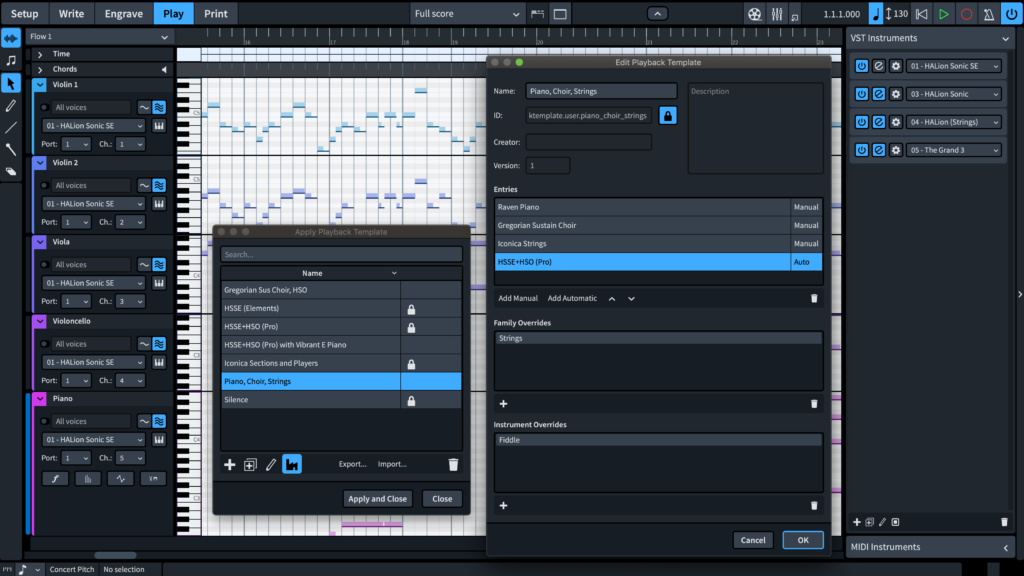
Setting up musical effects (dynamics and articulations etc) possible with such external VI libraries requires Expression maps to achieve the maximum control over the many (sometimes intricate yet critical) parameters needed for any given musical effect. These Expression maps tell Dorico how to translate these when rendering scores using its own playback engine.
Also new to Dorico 3 is the Expression Map Editor to streamline the process of working with what can be quite complex and involved such correspondences. It’s a delight to use: powerful yet intuitive.
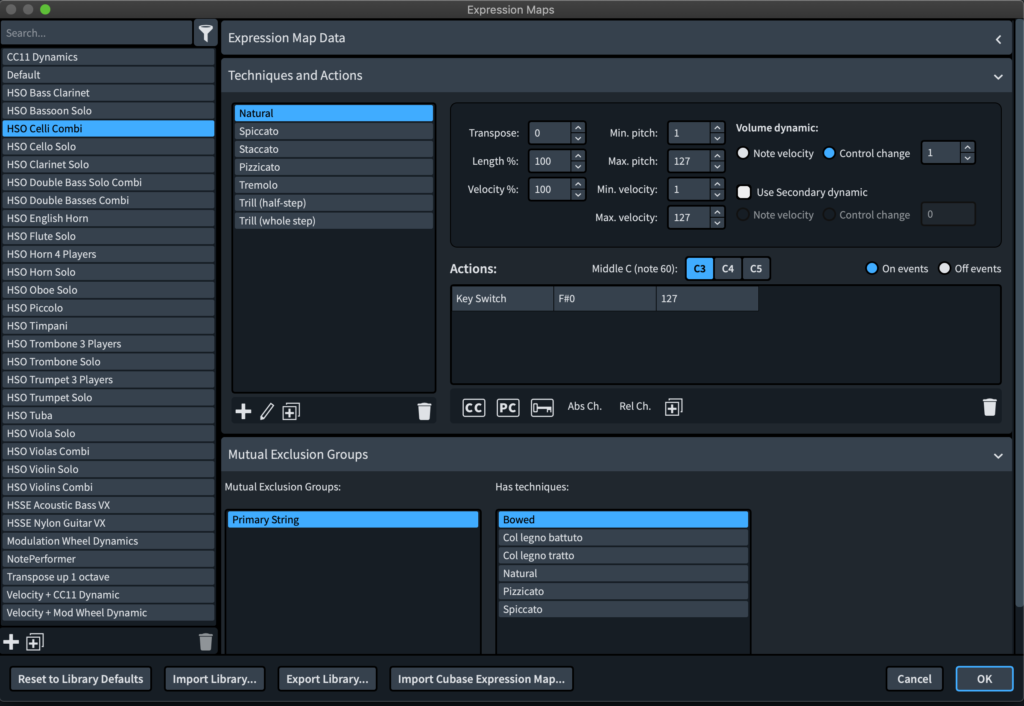
The Expression Maps editor has been significantly improved in Dorico 3, bringing two big advantages: it’s easier to use than the previous methods employed in Doricos 1 and 3. And it allows for a much greater degree of control. You can now, for instance, incorporate a secondary dynamic by assigning a key velocity or second/different CC (the message from MIDI known as a “continuous controllerâ€) in the parameters which control instruments.Â
Then, the fact that MIDI-channel changes can be assigned as absolute or relative for all playing techniques seems to be mere detail. But once you come across a circumstance where applying articulations to multiple VIs needing separate instances of the instrument, you’ll find this new way is of combining keyswitch and MIDI channel very effective.
That was not possible until now. And you can now define groups which prevent impossible or undesirable combinations by setting them as mutually exclusive, defining “Mutual Exclusion Groupsâ€.
Actual playing techniques (pizzicato, col legno etc) can be grouped in Dorico 3 such that the duration of a given technique can be shown by a line in the score to indicate continuation; this applies to multiple playing techniques treated together with the same connecting arrow or line. A score can be made instantly more readable and easier to use. Yet none of the subtlety and flexibility of such “styling†is lost.
User-defined Playback templates (new in Dorico 3) may become one of those features which you come to wonder how you ever managed without. A simple idea, effectively and cleverly implemented.
It’s possible in Dorico 3 to assign each voice in any given staff to a separate VST instrument… Voice 1 to alto trombone and Voice 2 to tenor trombone, say; so that articulations are set independently. Yet again, Dorico is making life simpler and more realistic for actual performance.
Similarly, there is now a separate lane for key velocity (volume) in each track. Further enhancements to the played sound have been introduced for glissando, swing, in percussion mapping, and with several other aspects of MIDI control.
Again, there are lots of details once you become familiar with Dorico 3, many of which you really are likely to come to rely on in the right circumstances… the detection of MIDI devices while Dorico is already running (previously it was necessary to restart the program after connecting, say, a keyboard); there’s a small MIDI activity indicator like the “lights†for channels in Dorico 3’s Mixer. There are improvements – small ones, but ones which will make things much easier to manage – in the case of such third party sounds and systems as NotePerformer, the instantiation of which Dorico 3 now handles automatically – even after changes in instrument allocation etc.
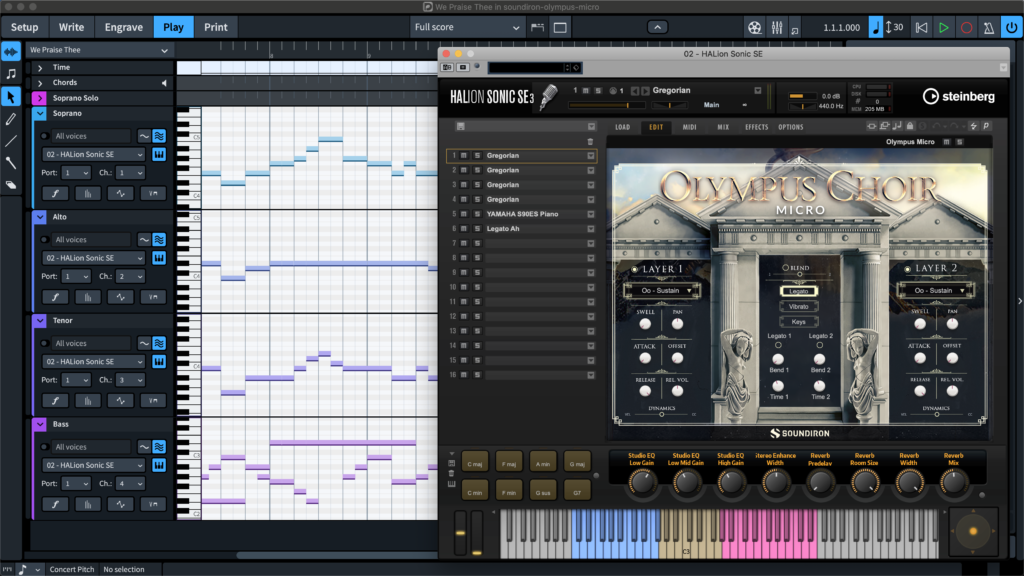
Lastly, Dorico 3 includes the Olympus Micro Choir Library, which is part of the upgrade (or initial installation). This is in many ways the “reference†choir library. Its inclusion with Dorico 3 does represent something of a compromise (only two vowels, “Ah†and “Oo†are available so far). But it sounds well and completely lacks the robotic artificiality of some choral implementations; many of the normally-needed articulations like sustain, marcato, staccato are provided.
Text
There’s probably more text on the average score than you might think. It’s certainly extremely important for composers, arrangers and players alike to be able to follow a score with written cues, for those originating the music to be able to annotate it intelligently and reliably; and – significantly – for the notation software to be able to insert, track and retain metadata for eventual presentation… titles, non-musical strings (dates, authorship, versions, copyright, opus number and page information etc) in such a way that time is saved but the final copy is attractive.
Dorico 3 excels in all these areas. Tokens are Dorico’s macros, which can be inserted as place holders for all the obvious items which need to be set once and displayed many times in the score… page number, title, date etc. Dorico 3 has more such tokens than ever, and there’s actually a new contextual menu in Engrave mode (right-/Ctrl-click in a frame) which shows all (your) tokens, categorized, in one location.
This new functionality also allows the use of musical symbols such as flats, “â™â€ (not “bâ€s) alongside “regular†text. There’s also a new Missing Fonts dialog.
Dorico 3 introduces a Comments editing panel. Importantly, there is a collaborative element to this: each comment is identified by its author’s initials allowing others working on the score to “reply†to it so that when more than one musician has contributed to the score, there’s a thread to preserve evolution.
Previous versions of Dorico have had fairly rudimentary control over lyrics. It’s much easier now to position the words which accompany your music, to treat them as text in their own right. You edit them in a dedicated dialog (accessed in a sub-menu by right-/Ctrl-clicking again… perhaps a little obscure until you get used to it). And you can copy and paste text to and from other applications. These new features significantly increase your ability to spot (spelling) errors, and to control syllabification.
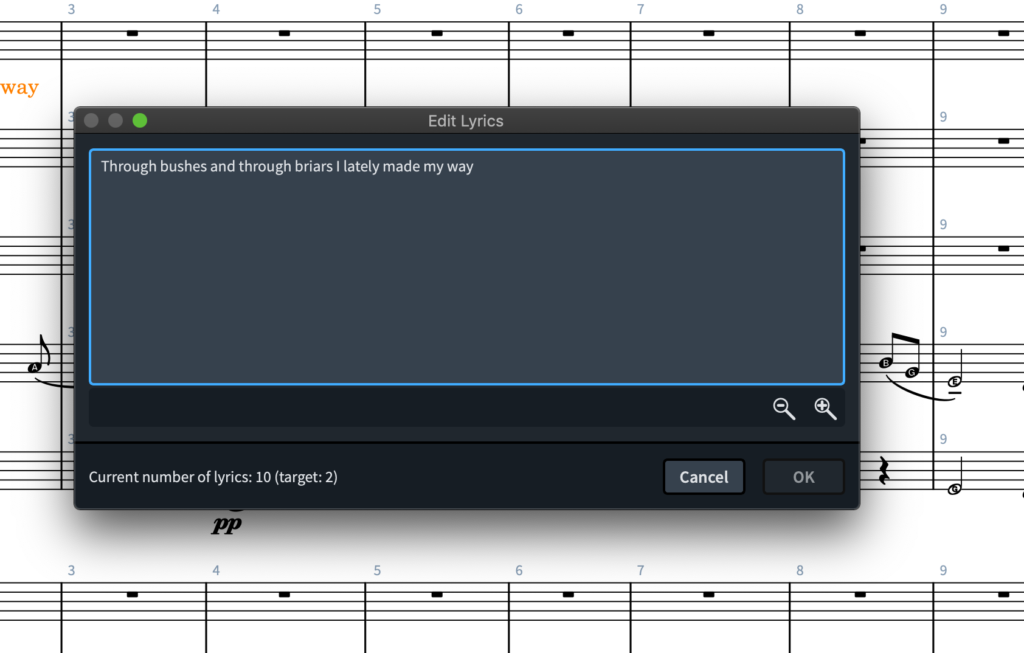
Although some of these changes follow the trend of moving fine-tuning to Engraving mode, this should be seen as welcome. Dorico proactively promotes and prizes focus: major creativity in Write mode. Final adjustments – if necessary – in Engraving mode. It’s also encouraging to see the continued importance which Dorico 3 attaches to making all of these new dialogs and editing functionality as intuitive and straightforward as they are in this release without ever sacrificing or compromising power. Working with these during this evaluation was a delight.
Other Improvements…
… are many. And – again – all those tested and used over the month since Dorico 3 became available worked as expected.
Particularly deserving of attention are the more streamlined, flexible, robust and altogether improved ways in which Dorico 3 manages probably the most basic of activities: note input.
You can now extend the caret with Shift+Up and Shift+Down vertically allowing note entry across multiple staves. New and improved ways to edit note duration and extension have been introduced. Indeed, control over selection and the management of areas of the score in general has been enhanced in this version of the software.
It’d be interesting for someone to calculate how much time (and potential frustration) can be eliminated by just these new features of Dorico 3 alone – as keystroke editors and expansion apps are eager to tell you.
There is more sophisticated and finer control over fingering (with other instruments than the guitar as detailed above), chord symbol regions, transposing clefs, multi-rests, staff labels, dynamics, navigation, arpeggios, ossias, page layout, and trills.
Some aspects of navigation have been tightened. Project Info, for example, which is extremely useful for your own text notes and memory publication, has ben expanded and made easier to use. The same goes for autosave.
Harmonics
The features newly introduced in Dorico 3 for for notating harmonics on stringed and fretted instruments are yet another example ofDorico’s winning philosophy of thinking as musicians think – not making musicians adapt their style(s) to what computers want.
You no longer need to work around Dorico’s previous limitations to notate either natural or artificialharmonics. The days of creating “fake†notes or changing note-head types are gone. Now built in and native to Dorico 3 is the new Type property in the Harmonics Properties panel. (Panels, remember, are the context-sensitive sets of options which slide up at the very bottom of a Dorico window… this latest addition is to be found by scrolling right.)
The diamond notepad conventions are automatically invoked, for example; and it’s possible effectively to “automate†any passage by selecting every note’s fundamental and then applying the value of the harmonic at a stroke. Note that playback support for harmonics is not implemented in Dorico 3. But it will come.

Catalina
At the time of this review’s publication here on MyMac, Apple’s next operating system (10.15) has not yet been released. In common with a significant number of other producers of complex software, Steinberg is advising caution. Hold off for the moment.
This is certainly not because of any kind of inherent incompatibility between Dorico 3 and macOS Catalina (10.15). Nor is this advice an excuse for inadequate testing or preparation on Steinberg’s part. It is, rather, the consequence of significant changes in the security model introduced by Apple in 10.15.
To make the most of some of its core functionality Dorico also relies on transparent and fully-functional integration with third-party code and plug-ins – like VST instruments; and of course on the copyright-protection system behind the Soft-eLicenser.
As things stand at the start of October 2019, there are still aspects of Catalina’s complex entitlements and notarization requirements to make this integration possible that are too new merely to assume compatibility with Dorico. Things may still be changing right up until Catalina’s official release. So it really is wise to expect a short delay in upgrading (to Catalina) if you want to avail yourself of trouble-free operation of all aspects of Dorico (3). Seasoned Steinberg watchers, however, know with certainty that full compatibility is a priority, and that this will be achieved and official compatibility will be announced as soon as it safely can be.
Similar diligence and determination should be expected where bugs unconnected with the OS upgrade but discovered and reported after Dorico 3’s initial release are concerned: the team at Steinberg has always been extremely assiduous in this respect!
Conclusion: Let’s be clear: any one of the three areas in which Dorico 3 is significantly superior to its earlier versions (new features; new and superior ways to achieve already-implemented results; smaller – but significant – enhancements to retain parity but remove what have been identified as stumbling blocks for some users) would require at least a year of hard work and a belief in product and project.
That all three have been done for Dorico 3 and that you’ll pay less than $100 to get them (upgrading from Dorico 2) is remarkable. The numerical list of changes is huge. The quality of these changes extremely impressive.
Steinberg’s marketing material doesn’t push Dorico’s advantages over Finale and Sibelius aggressively. That’s probably because those advantages are obvious to those with eyes to see. Yes, there are aspects characteristic of a longer-standing product which Dorico lacks… an array of third party plug-ins, for example; and several printed books and manuals to serve as guides and extended tutorials – although the full documentation for Dorico appears more and more quickly nowadays.
But this is more than made up for – in this case – in two ways.
Dorico already integrates the functionality of what for other software may be handled by (third party) plug-ins.
Then, efficient, effectively almost round the clock (!), support from Steinberg’s Dorico team and an extensive experienced and knowledgeable user base.
It’s also made up for by the sheer attractiveness, streamlined design and sophisticated intuitive approach of the user interface. Yes – Dorico 3 looks even more appealing and professional – in small, but significant ways.
As said, Dorico offers you a musical world in which to operate.
There are many hundred aspects of the entry and control of notated music like this. Yet the menus and options, settings and zones of Dorico 3’s screen which afford such control are never cluttered, overwhelming or confusing. This remains a remarkable achievement.
If you’re new to Dorico, jump on board now. If you own a previous version, don’t hesitate. This is a product that can be recommended without hesitation.
Pros: Huge and (musically) significant array of new features. Many improvements to existing functionality. Excellent support. Appropriate price when considering the depth and range of what Dorico 3 does.
Cons: None significant. Dorico has set the bar so high that there are always likely to be those who point up a “missing†feature. But these are insignificant in the big picture and will rarely obstruct creativity or presentation for performance – especially when to consider how far Dorico has come thus far is to have implicit faith in its future.
System requirements:
- 64-bit Intel or AMD multi-core (i5 or faster recommended)
- 4GB RAM (more recommended). SSD recommended.
- macOS 10.12 or later essential
- Internet connection for download and registration etc.
MyMac.com Rating: 10 out of 10
Pricing (download):
- Dorico Pro 3 full version: $559.99
- Dorico Pro 3 full version (education): $339.99
- Dorico Pro 3 upgrade from Dorico 2: $99.99
- Dorico Pro 3 upgrade from Dorico 1: $149.99
- Dorico Pro 2 cross-grade from Sibelius, Finale: $279.99
- Dorico Pro 2 cross-grade (education) from Sibelius, Finale: $159.99
- Dorico Elements 3 full version: $99.99
- Dorico Elements 3 (education): $66.99
- Dorico Elements 3 upgrade from Dorico Elements 2: $29.99
- Dorico Elements 3 upgrade from Dorico LE: $46.99

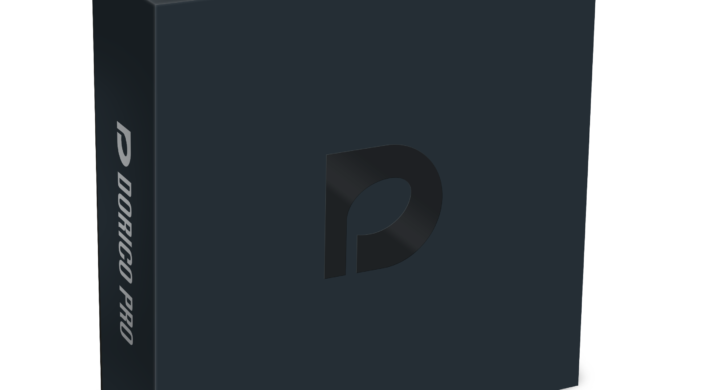
Leave a Reply
You must be logged in to post a comment.